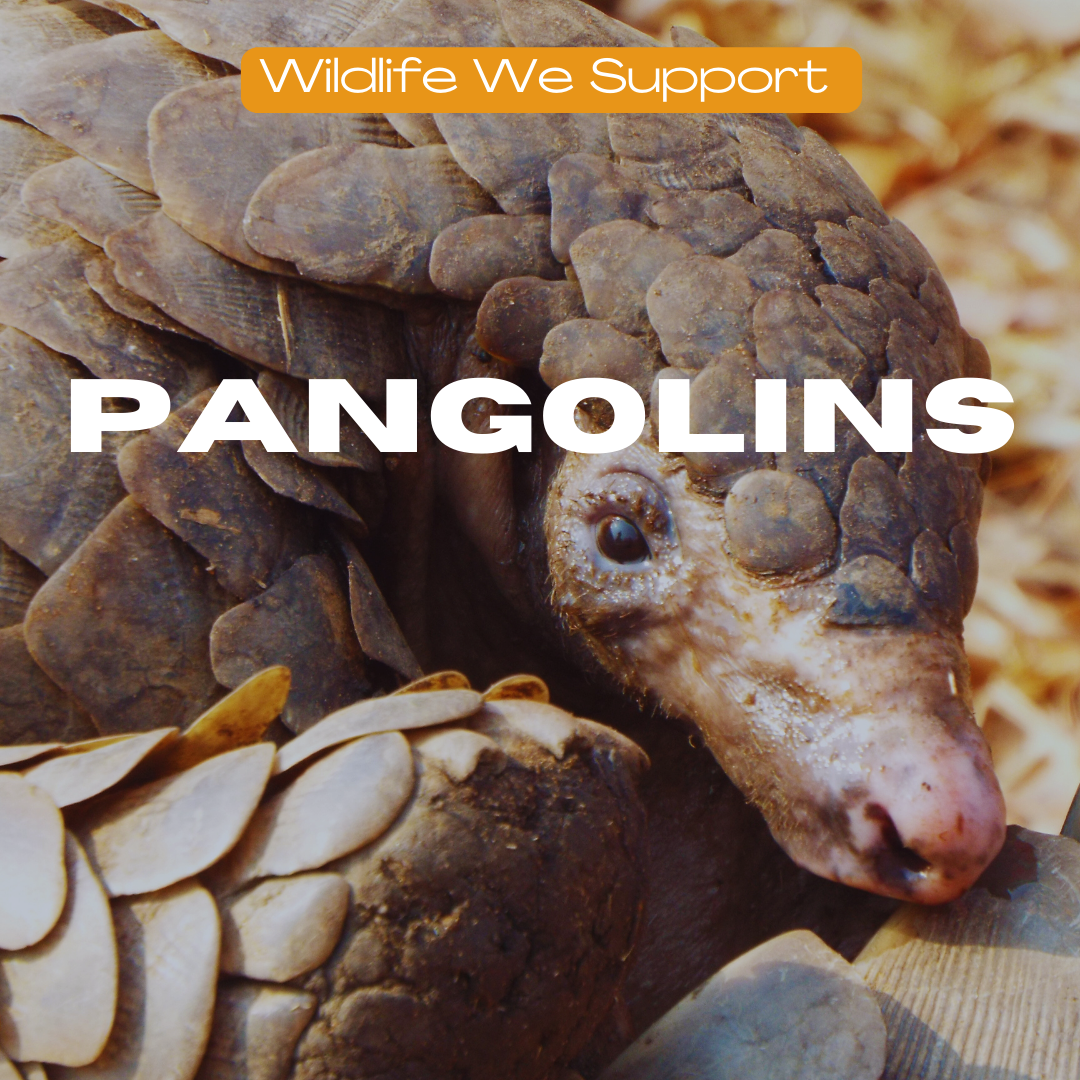Pangolins: #1 trafficked mammal in the world!
2.7 Million African Pangolins are killed every year
Photo Credit: Louis Mornaud
Pangolins: The Gentle Survivors We’re Fighting For
If you’re ever fortunate enough to see a pangolin in the wild, you’ll never forget it. With their shy, almost prehistoric beauty and whip-like tongues that can stretch nearly half a meter to scoop up ants and termites, pangolins are among nature’s quiet caretakers—controlling insect populations and keeping ecosystems in balance.
Yet today, these extraordinary mammals hold a heartbreaking title: the most heavily trafficked mammals in the world. All eight species are now listed under CITES Appendix I, which bans international commercial trade. Despite this, trafficking persists at alarming levels. In Africa alone, millions have been poached in the past decade, their meat sold as a luxury dish and their scales falsely promoted as medicine—even though pangolin scales are made of keratin, the same material as our fingernails, offering no medicinal value whatsoever.
The crisis is fueled by demand in Asia, particularly in China and Vietnam, where scales are used in traditional remedies and meat is treated as a status symbol. Seizures regularly involve tonnes of pangolin scales, each representing thousands of lives lost.
But there is hope. Conservationists, governments, and organizations like ours are working tirelessly to protect pangolins—through law enforcement, habitat protection, rescue and rehabilitation, and by challenging dangerous myths that keep demand alive. In 2025, the U.S. even proposed bringing seven pangolin species under its Endangered Species Act, a step that could strengthen global protection.
At Over and Above Africa, we are committed to ensuring pangolins do not disappear on our watch. These gentle survivors deserve more than to be remembered as statistics in the illegal wildlife trade. They deserve our protection, our advocacy, and our voices—until the world values them alive, not as commodities.
The Four Species of African Pangolin
A Temick’s Ground pangolin feeding in South Africa. As Nicci Wright says in “Breaking Their Silence” - they are bewitching and steal your heart!
There are eight species of pangolins total. Four live in Asia and four in Africa. The four African pangolins are the Ground Pangolin, Giant Pangolin, Cape Pangolin and Long-Tailed Pangolin.
They can grow as large as 4.5 feet! Curiously, not all pangolin species eat the same kinds of food. They have a definite preference for specific types of ants and termites, which is why it can be hard to rehabilitate them. Their food tastes correlate with the species of termite and ant in the regions they were poached from.
On the rare occasion they are freed from poachers still alive, they are not easy to rehabilitate. Only a few trusted people and facilities are permitted this privilege. Our friend and wildlife expert, Nicci Wright is one of them. Nicci allowed us to accompany her as she took two of pangolin males she and her team rehabilitated, out feeding. They were released back into the wild shortly after we left to join the other success stories in their tracking initiative. We document our whole encounter with Nicci in the award-winning film; “Breaking Their Silence: Women on the Frontline of the Poaching War”.
“The humble pangolin, a scaly anteater, is one of the most endangered animals on the planet because of poaching. The pangolin runs the risk of becoming extinct before most people have even heard of them.”
Pangolin Facts: Mysterious, Gentle Creatures of the Night
They are often confused with anteaters, with their similar looking body and pointed nose, but they are more related to dogs and other mammals that give birth to their young (as opposed to lay eggs). Their only line of defense when threatened, is to roll up into a tight scaly, ball and wait for the threat to pass. Then, they unroll and carry on.
Pangolins are considered creatures of the night, rarely seen during daylight hours. Their elusive nature adds to their mystique.
Handling pangolins is also very specialized. They do not do well in captivity, suffer from dehydration, and can be very difficult to treat. Facilities like the Johannesburg Wildlife Veterinary Hospital have had enough experience with treating them to successfully bring them back to health and release them.
And much like the rapidly disappearing rhino, whose horn is also made of keratin, pangolins command a high price on the black market - more than $3000/kg.
Join Us in Protecting Pangolins
Pangolins have survived on Earth for over 80 million years — but without urgent action, they could vanish within ours. Every pangolin saved is a step toward ending the world’s most tragic wildlife trade.
At Over and Above Africa, we work alongside conservationists on the ground to fight poaching, rescue and rehabilitate pangolins, and educate communities to reduce demand. But we can’t do it alone.
🌍 Your voice matters. Your support saves lives.
Donate today to help fund rescue, care, and anti-poaching patrols.
Share this message to raise awareness about the most trafficked mammal on Earth.
Stand with us to make sure pangolins have a future in the wild.
Together, we can turn the tide. Together, we can ensure pangolins are treasured as living beings — not traded as commodities.
How Many Pangolins Are Left in World?
Because pangolins live such secluded lives, it is difficult to estimate how many pangolins still remain in the wild. However, we do know that their populations cannot possibly sustain the decimation of demand caused by poachers and the illegal wildlife trade, which rips more than 2 million pangolins from the wild every year. These gentle but helpless creatures are estimated to be down to a mere 50,000 worldwide.
What We’re Doing To Help Pangolins
From helping fund a new telemetry system for rehabilitated pangolins rescued from poachers to nursing babies who are left without mothers by poachers, learn more about our efforts to protect Africa’s vulnerable wildlife.
Why Pangolins are Important
Pangolins are often referred to as, 'the guardians of the forest' because they help maintain a balanced ecosystem. Pangolins' diet of termites helps regulate the forest from insect infestation and destruction. It’s been estimated that over one year, a pangolin can eat upwards of 70 million ants/termites.
How Can You Help?
Share their story to build awareness and bring attention to their plight
Report wildlife crime and support sustainable products
Hold a local fundraiser in your community to raise funds to help our work





